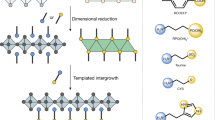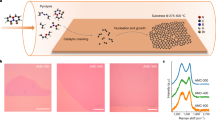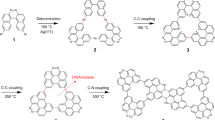Abstract
Layered materials have attracted tremendous interest for accessing two-dimensional structures. Materials such as graphite or transition metal dichalcogenides, in which the layers are held together by van der Waals interactions, can be exfoliated through a variety of processes in a manner that retains the structure and composition of the monolayers, but this has proven difficult for solids with stronger interlayer interactions. Here, we demonstrate the exfoliation of AgCrS2, a member of the AMX2 family (where A is a monovalent metal, M is a trivalent metal and X is a chalcogen), through intercalation with tetraalkylammonium cations, chosen for their suitable redox potential. The as-exfoliated nanosheets consist of Ag layers sandwiched between two CrS2 layers, similar to their structure in the bulk. They show superionic behaviour at room temperature, with an ionic conductivity of 33.2 mS cm−1 at 298 K that originates from Ag+ ions rapidly hopping between neighbouring tetrahedral interstices; in the bulk, this behaviour is only observed above 673 K.

This is a preview of subscription content, access via your institution
Access options
Access Nature and 54 other Nature Portfolio journals
Get Nature+, our best-value online-access subscription
$29.99 / 30 days
cancel any time
Subscribe to this journal
Receive 12 print issues and online access
$259.00 per year
only $21.58 per issue
Buy this article
- Purchase on Springer Link
- Instant access to full article PDF
Prices may be subject to local taxes which are calculated during checkout




Similar content being viewed by others
Data availability
The experimental procedures and characterization of all AMX2 compounds and corresponding 2D structures are provided in the Supplementary Information. Source data are provided with this paper. All other data supporting the findings of this study are available within this article and its Supplementary Information.
References
Novoselov, K. S. et al. Electric field effect in atomically thin carbon films. Science 306, 666–669 (2004).
Chhowalla, M. et al. The chemistry of two-dimensional layered transition metal dichalcogenide nanosheets. Nat. Chem. 5, 263–275 (2013).
Tan, C. et al. Recent advances in ultrathin two-dimensional nanomaterials. Chem. Rev. 117, 6225–6331 (2017).
Yang, H., Kim, S. W., Chhowalla, M. & Lee, Y. H. Structural and quantum-state phase transitions in van der Waals layered materials. Nat. Phys. 13, 931–937 (2017).
Lin, Y., Williams, T. V. & Connell, J. W. Soluble, exfoliated hexagonal boron nitride nanosheets. J. Phys. Chem. Lett. 1, 277–283 (2010).
Coleman, J. N. et al. Two-dimensional nanosheets produced by liquid exfoliation of layered materials. Science 331, 568–571 (2011).
Zeng, Z. et al. An effective method for the fabrication of few‐layer‐thick inorganic nanosheets. Angew. Chem. Int. Ed. 51, 9052–9056 (2012).
Splendiani, A. et al. Emerging photoluminescence in monolayer MoS2. Nano Lett. 10, 1271–1275 (2010).
Wang, Q. H., Kalantar-Zadeh, K., Kis, A., Coleman, J. N. & Strano, M. S. Electronics and optoelectronics of two-dimensional transition metal dichalcogenides. Nat. Nanotechnol. 7, 699–712 (2012).
Takagaki, A. et al. Exfoliated nanosheets as a new strong solid acid catalyst. J. Am. Chem. Soc. 125, 5479–5485 (2003).
Ma, R. & Sasaki, T. Two-dimensional oxide and hydroxide nanosheets: controllable high-quality exfoliation, molecular assembly, and exploration of functionality. Acc. Chem. Res. 48, 136–143 (2015).
Puthirath Balan, A. et al. Exfoliation of a non-van der Waals material from iron ore hematite. Nat. Nanotechnol. 13, 602–609 (2018).
Kamysbayev, V. et al. Covalent surface modifications and superconductivity of two-dimensional metal carbide MXenes. Science 369, 979–983 (2020).
Du, Z. et al. Conversion of non-van der Waals solids to 2D transition-metal chalcogenides. Nature 577, 492–496 (2020).
Masuda, Y., Hamada, Y., Seo, W. S. & Koumoto, K. Exfoliation of layers in NaxCoO2. J. Nanosci. Nanotechnol. 6, 1632–1638 (2006).
Naguib, M., Mochalin, V. N., Barsoum, M. W. & Gogotsi, Y. 25th anniversary article: MXenes: a new family of two-dimensional materials. Adv. Mater. 26, 992–1005 (2014).
Song, X. et al. Soft chemical synthesis of HxCrS2: an antiferromagnetic material with alternating amorphous and crystalline layers. J. Am. Chem. Soc. 141, 15634–15640 (2019).
Li, Y. et al. A general Lewis acidic etching route for preparing MXenes with enhanced electrochemical performance in non-aqueous electrolyte. Nat. Mater. 19, 894–899 (2020).
Takada, K. et al. Superconductivity in two-dimensional CoO2 layers. Nature 422, 53–55 (2003).
Kogar, A. et al. Observation of a charge density wave incommensuration near the superconducting dome in CuxTiSe2. Phys. Rev. Lett. 118, 027002 (2017).
Engelsman, F., Wiegers, G., Jellinek, F. & Van Laar, B. Crystal structures and magnetic structures of some metal(I) chromium(III) sulfides and selenides. J. Solid State Chem. 6, 574–582 (1973).
Ko, K. T. et al. RKKY ferromagnetism with Ising-like spin states in intercalated Fe1/4TaS2. Phys. Rev. Lett. 107, 247201 (2011).
Yano, R. & Sasagawa, T. Crystal growth and intrinsic properties of ACrX2 (A = Cu, Ag; X = S, Se) without a secondary phase. Cryst. Growth Des. 16, 5618–5623 (2016).
Hibma, T. The mixed conductor properties of AgCrS2. Solid State Commun. 33, 445–448 (1980).
Seo, D.-H. et al. The structural and chemical origin of the oxygen redox activity in layered and cation-disordered Li-excess cathode materials. Nat. Chem. 8, 692–697 (2016).
Cheng, Q., Yang, T., Li, Y., Li, M. & Chan, C. K. Oxidation–reduction assisted exfoliation of LiCoO2 into nanosheets and reassembly into functional Li-ion battery cathodes. J. Mater. Chem. A 4, 6902–6910 (2016).
Lin, Z. et al. Solution-processable 2D semiconductors for high-performance large-area electronics. Nature 562, 254–258 (2018).
Brüesch, P., Hibma, T. & Bührer, W. Dynamics of ions of the two-dimensional superionic conductor AgCrS2. Phys. Rev. B 27, 5052–5061 (1983).
Abramova, G. M. et al. Magnetic properties, magnetoresistance, and Raman spectra of CuVxCr1−xS2. Phys. Solid State 51, 532–536 (2009).
Peng, J. et al. Very large-sized transition metal dichalcogenides monolayers from fast exfoliation by manual shaking. J. Am. Chem. Soc. 139, 9019–9025 (2017).
Gerards, A., Boukamp, B. & Wiegers, G. Neutron diffraction study of the order-disorder transition in AgCrS2. Solid State Ion. 9, 471–474 (1983).
Xie, L. et al. Direct atomic-scale observation of the Ag+ diffusion structure in the quasi-2D “liquid-like” state of superionic thermoelectric AgCrSe2. J. Mater. Chem. C 7, 9263–9269 (2019).
Makiura, R. et al. Size-controlled stabilization of the superionic phase to room temperature in polymer-coated AgI nanoparticles. Nat. Mater. 8, 476–480 (2009).
Bachman, J. C. et al. Inorganic solid-state electrolytes for lithium batteries: mechanisms and properties governing ion conduction. Chem. Rev. 116, 140–162 (2016).
Wu, G. et al. Transport properties and the large anisotropic magnetoresistance of CuxNbS2 single crystals. J. Phys. Condens. Matter 21, 275601 (2009).
Den Berg, J. M. V.-V. On the ternary phases AlxNbSe2 and CuxNbSe2. J. Less Common Met. 26, 399–402 (1972).
Scholz, G. A. & Frindt, R. F. Structure and staging of intercalated AgxTaS2 and AgxTiS2. Mater. Res. Bull. 15, 1703–1716 (1980).
Acknowledgements
C.W. acknowledges support from the National Key R&D Program on Nano Science & Technology of the MOST (2017YFA0207301), the National Natural Science Foundation of China (21925110, 21890751 and 91745113), the National Program for Support of Top-notch Young Professionals, the Fundamental Research Funds for the Central Universities (WK2060190084), the Major Program of Development Foundation of Hefei Center for Physical Science and Technology (2016FXZY001) and the Users with Excellence Project of Hefei Science Center CAS (2021HSC-UF004). Y.X. acknowledges support from the Strategic Priority Research Program of the Chinese Academy of Sciences (XDB36000000). X.W. acknowledges support from the National Key R&D Program on Nano Science & Technology of the MOST (2016YFA0200602, 2018YFA0208603) and the National Natural Science Foundation of China (22073087). J.P. acknowledges support from the National Natural Science Foundation of China (22005284) and the National Postdoctoral Program for Innovative Talents (BX20190308). Y.G. acknowledges support from the National Natural Science Foundation of China (U2032161) and the Youth Innovation Promotion Association CAS (2018500). All calculations were supported by the Super Computer Center of USTCSCC and SCCAS.
Author information
Authors and Affiliations
Contributions
C.Z.W. conceived the idea and experimentally realized the study, co-wrote the paper and supervised the entire project and is responsible for the infrastructure and project direction. J.P., Y.H.L. and H.F.L. contributed equally to this work; they experimentally realized the study, analysed the data and co-wrote the paper. This work was assisted by Y.Q.S., J.J.W., H.F.L. and Y.Q.G. HAADF-STEM data were collected by Y.L. Theoretical calculations were carried out by H.F.L., Y.X.L., Z.W.Z. and X.J.W. Y.X. supervised the whole experimental procedure and co-wrote the paper. All authors discussed the results and commented on and revised the manuscript.
Corresponding author
Ethics declarations
Competing interests
The authors declare no competing interests.
Additional information
Peer review information Nature Chemistry thanks Kian Ping Loh and the other, anonymous, reviewer(s) for their contribution to the peer review of this work.
Publisher’s note Springer Nature remains neutral with regard to jurisdictional claims in published maps and institutional affiliations.
Supplementary information
Supplementary Information
Supplementary Figs. 1–25, Tables 1 and 2, Discussion and refs. 1–19.
Source data
Source Data Fig. 1
Statistical source data.
Source Data Fig. 2
Statistical source data.
Source Data Fig. 4
Statistical source data.
Rights and permissions
About this article
Cite this article
Peng, J., Liu, Y., Lv, H. et al. Stoichiometric two-dimensional non-van der Waals AgCrS2 with superionic behaviour at room temperature. Nat. Chem. 13, 1235–1240 (2021). https://doi.org/10.1038/s41557-021-00800-4
Received:
Accepted:
Published:
Issue Date:
DOI: https://doi.org/10.1038/s41557-021-00800-4
This article is cited by
-
Synthesis of atomically thin sheets by the intercalation-based exfoliation of layered materials
Nature Synthesis (2023)
-
Electrochemical molecular intercalation and exfoliation of solution-processable two-dimensional crystals
Nature Protocols (2023)
-
1D/2D composite subnanometer channels for ion transport: The role of confined water
Nano Research (2023)
-
Emergence of superconductivity in 2D Cu0.65NbS2 nanosheets via copper ion hopping
Science China Materials (2023)
-
A ferromagnetic hybrid Weyl semimetal in two dimensions: the monolayer AgCrS2
Journal of Materials Science (2023)



